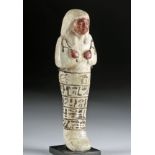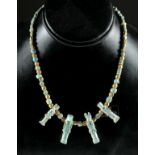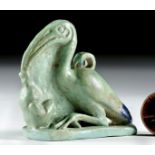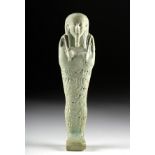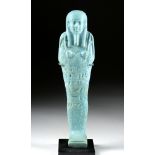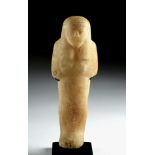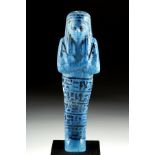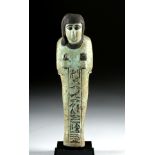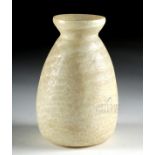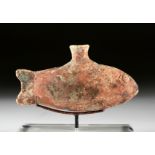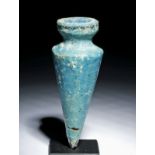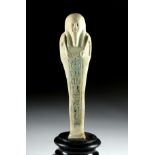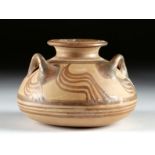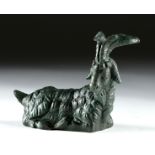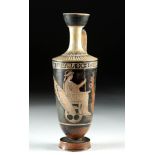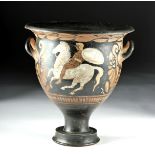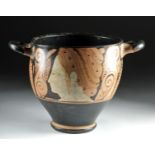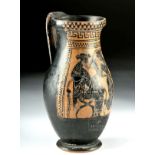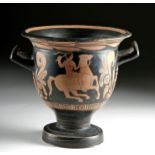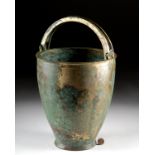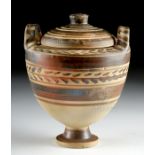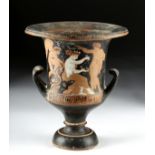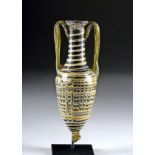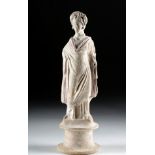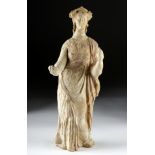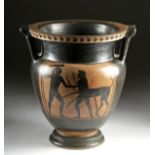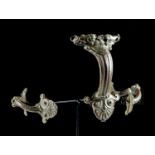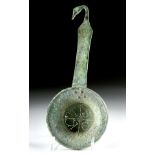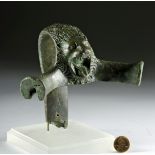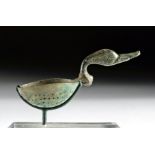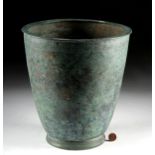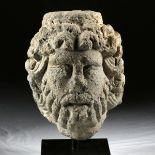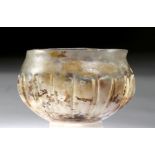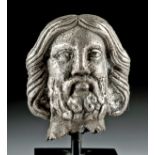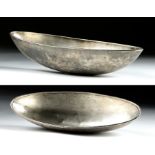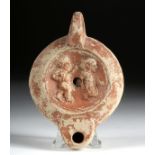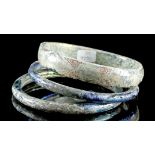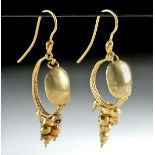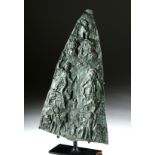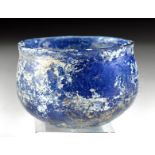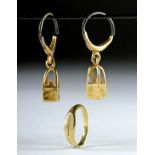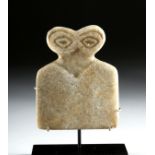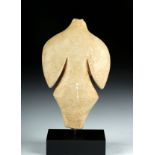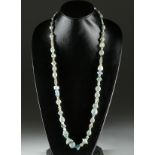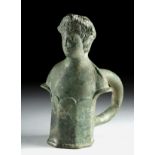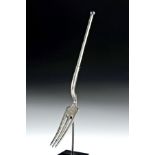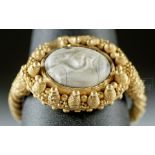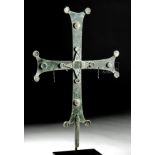Filtered by:
- Category
- List
- Grid
A subscription to the Price Guide is required to view results for auctions ten days or older. Click here for more information
Ancient Egypt, New Kingdom, Ramesside Period, 19th Dynasty, ca. 1279 to 1213 BCE. A gorgeous mold-formed faience ushabti covered in a clear glaze ...
Egypt, Late Dynastic Period, 26th to 31st Dynasty, ca. 664 to 332 BCE. A gorgeous necklace displaying dozens of small beads and 4 figural amulets....
Ancient Egypt, Third Intermediate Period to Late Dynastic Period, ca. 1070 to 332 BCE. A beautifully preserved faience amulet in the form of an ib...
Egypt, Late Dynastic Period, 26th to 31st Dynasty, ca. 664 to 332 BCE. A gorgeous mold-formed faience ushabti covered in soft green glaze across m...
Ancient Egypt, Saite Period, Twenty-Sixth Dynasty (XXVI), ca. 664 to 525 BCE. An excellent example of a well-made faience ushabti, inscribed with ...
Ancient Egypt, Third Intermediate Period, 21st to 25th Dynasty, ca. 1069 to 664 BCE. A standing ushabti figure, hand-carved from a creamy-yellow a...
Ancient Egypt, Third Intermediate Period, 21st Dynasty, ca. 1069 to 945 BCE. A stunning mold-formed faience ushabti enveloped in a brilliant cornf...
Ancient Egypt, New Kingdom, Ramesside Period, 19th to 20th Dynasty, ca. 1295 to 1070 BCE. A mold-formed faience ushabti covered in a pale blue-gre...
Ancient Egypt, Late Dynastic Period, 26th to 31st Dynasty, ca. 664 to 332 BCE. A heavy, well preserved alabastron, meticulously hand-carved from c...
Ancient Egypt, New Kingdom, probably Amarna Period (18th Dynasty), ca. 1352 to 1336 BCE. A wonderfully preserved ceramic vessel in the form of a f...
Ancient Egypt, New Kingdom, 18th to 20th Dynasty, ca. 1549 to 1070 BCE. An intriguing votive plumb bob which is mold-formed from faience and envel...
Egypt, Late Dynastic Period, 26th to 31st Dynasty, ca. 664 to 332 BCE. A fabulous mold-formed faience ushabti covered in lustrous layers of soft b...
Ancient Greece, Sub-Mycenaean Period, ca. 1100 to 950 BCE. A wheel-thrown pottery pyxis of a squat form with a series of concentric circles surrou...
Greek, Attica, ca. 530s BCE. A very rare black-figure kyathos - a dipper or ladle with a high vertical handle topped by a shell-shaped ornament - ...
Late Roman / early Byzantine period, ca. late 3rd to 5th century CE. A fabulous hollow-cast bronze figurine depicting a recumbent goat with a bulb...
Ancient Greece, Athens (Attic), ca. 470 to 460 BCE. A very special red-figured lekythos depicting a female goddess, most likely Demeter, dressed i...
Magna Graecia, Campanian, Capua, by a painter of Trendall's AV Group, either the Libation Painter or the Astarita Painter, ca. 340 to 320 BCE. A w...
Classical World, Italy, Faliscan, ca. late 4th century BCE. A very large - perhaps the largest we have seen in quite some time - and very fine red...
Greece, Athens, subject matter similar to the Group of Vatican G. 50, ca. 525 to 475 BCE. A spectacular pottery pitcher decorated in Black-figure ...
Magna Graecia, Lucanian, probably Pisticci Painter, ca. 430 to 410 BCE. A lovely red-figure pinkware pottery bell krater depicting a nude athlete ...
Ancient Greece, early Hellenistic Period, ca. late 4th to 3rd century BCE. An exquisite cast-bronze situla (Latin for bucket or pail) of a sizable...
Magna Graecia, Southern Italy, Messapia, ca. 4th century CE. A gorgeous wheel-thrown pottery lebes gamikos with an inverted bell-shaped body, a pl...
Greece, Athens, Late Attic, ca. 350 BCE. A lovely calyx krater depicting intriguing figural scenes and wonderful decorative motifs in the field. ...
Large Greek Core Formed Amphora
Ancient Greece, Classical Period, ca. 2nd to 1st century BCE. Comprised of a deep forest green glass body with opaque yellow and white trailing wr...
Magna Graecia, Apulia, Canosan Hellenistic Period, ca. 3rd century BCE. Breathtakingly beautiful and in wonderful condition! An elegant votive fig...
Magna Graecia, Apulia, Canosan Hellenistic Period, ca. 3rd century BCE. A very large mold-made terracotta votive figure depicting a goddess standi...
Central Italy, Tarquinia, Etruscan, attributed to the Micali Painter or one of his close followers, ca. 500 to 490 BCE. A magnificent column krate...
Greece, Classical period, ca. mid 5th century BCE. A trio of incredibly-preserved cast bronze handles from a massive hydria, a water vessel with a...
Classical World, Central Italy, Etruria, ca. 5th to 4th century BCE. A fabulous and finely-preserved example of a bronze wine strainer with a long...
Classical World, Etruria, ca. 6th to 5th century BCE. A handsome cast bronze hydria handle adorned by a magnificent lion head - the wild feline's ...
Central Italy, Etruria, ca. 600 to 400 BCE. A most unusual fibula, in the form of a wine strainer with a handsome duck head handle. The bowl is ro...
Ancient Greece, early Hellenistic Period, ca. late 4th to 3rd century BCE. A stunning cast-bronze situla (Latin for bucket or pail) of a tapering ...
Roman, Imperial Period, ca. 1st to 3rd century CE. A finely sculpted basalt head of Serapis wearing a modius crown. Serapis, god of fertility and...
Small Roman Glass Ribbed Cup
Roman, early Imperial Period, ca. 1st to early 2nd century CE. A fine cup formed from translucent glass boasting pale yellow hues and faint streak...
Roman, Imperial Period, ca. 1st to 3rd century CE. A meticulously detailed, hollow cast silver head of Jupiter (Greek Zeus) - the bearded king of ...
Roman, Imperial Period, ca. 1st to 3rd century CE. An elegant ovoid bowl comprised of high quality silver (95% silver). Simple yet elegant. Perhap...
Roman, Imperial Period, ca. 1st to 2nd century CE. A fine mold-formed oil lamp with a planar base with a planta pedis reading "LMVHPHILE," rounded...
Roman, Imperial Period, ca. 1st to 3rd century CE (2 cobalt blue examples). Near East, Holy Land, Byzantine, ca. 8th to 10th century CE (larger br...
Roman, Imperial Period, ca. 2nd to 3rd century CE. A magnificent pair of gold earrings from ancient Rome (comprised of 80% gold or the equivalent ...
Roman, Imperial Period, ca. first half of the 3rd century CE. A hammered sheet-bronze standard of a triangular form depicting four registers of an...
Roman, early Imperial Period, ca. 1st century CE. A fabulous free-blown cup made from near-opaque, cobalt-blue glass with a rounded base and smoot...
Roman, Imperial Period, ca. 1st to 3rd century CE. A lovely ensemble of precious gold jewelry from ancient Rome. First, a gold ring with an impres...
Ancient Near East, Tel Brak, modern day Syria, Middle Uruk Period, ca. 3700 to 3500 BCE. An abstract carved marble figure with a flat body surmoun...
Rare Anatolian Marble Kilia Idol
Ancient Western Asia, Anatolia, Early Bronze Age II, ca. 2700 to 2400 BCE. A creamy brown marble idol of the kilia (kiliya) variety from the Cycla...
Western Asia, Anatolia, Early Bronze Age II, ca. 2700 to 2400 BCE. A creamy brown marble idol of the kilia (kiliya) variety from the Cycladic scul...
Ancient Near East, Sumeria, Bronze Age, ca. 2nd millennium BCE. A collection of approximately 100 faience beads on a modern cord, all of varied fo...
Near East/Holy Land, Byzantine Empire, ca. 4th to 6th century CE. A heavy, cast chariot rein guide, made from cast bronze, in the form of a youthf...
Near East/Holy Land, Byzantine Empire, ca. 12th to 15th century CE. An incredibly rare 92% silver fork of delicate form, with incised motifs above...
Ancient Near East / Holy Land, Byzantine Empire, ca. 10th to 12th century CE. A stunning and wearable ring comprised of 98% gold (equivalent to 22...
Ancient Near East / Holy Land, Byzantine Empire, ca. 12th to 14th century CE. A fantastic cast brass processional cross composed of two flared sec...

